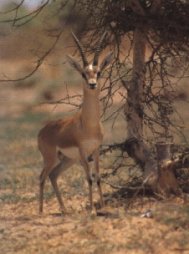ANTELOPE

|
The name for a large group of cud-chewing ungulates (hoofed mamals)
in the family Bovidae that range in size from the royal antelope, only 10 inches
high, to the oxlike giant eland that may weigh over 1,000 pounds. They are
handsome animals and are known for their speed and grace. Early zoologists
recognized only one species, the Indian antelope, but today about 100 species
are known.
The horns are the outstanding character by which a species of antelope
may be recognized. In most species, both sexes have horns that are neither
branched nor forked and never shed. They may be long and straight, twisted
like a corkscrew,swept over like a sickle, or lyre-shaped; they never grow in
close curls like the horns of a ram, or in a spread like those of oxen. The horns
consist of a hollow, horny sheath grown over a bony core which is an outgrowth of
the animal's skull. All antelope with the exception of the four-horned antelope, have a single pair of horns.
Most antelope are sociable and live in herds consisting of a few individuals up to 10,000;
however, few are shy solitary. Antelope frequent dense forests, wide open plains, deserts, marshes,
swamps, and rockey mountain slopes. The largest variety and greatest abundance of antelope are found
in Africa, but they are also widespread over southern Asia. There are no true antelope in the New World.
Antelope
 Back to main page
Back to main page

